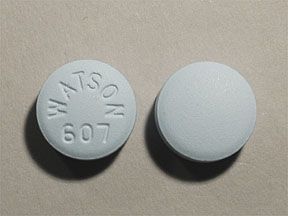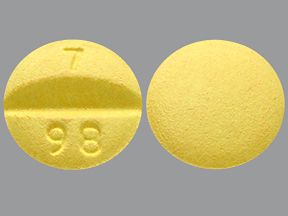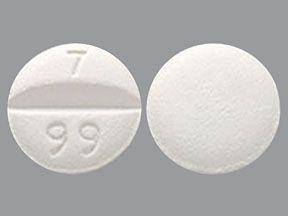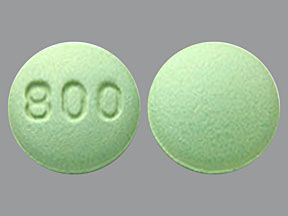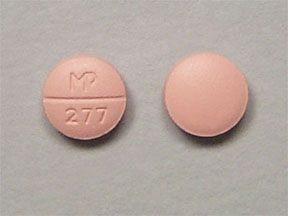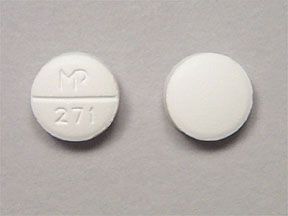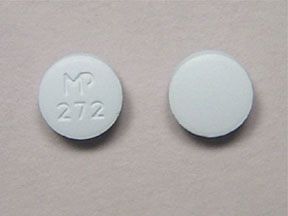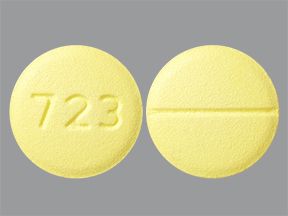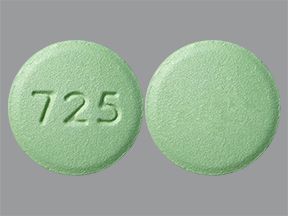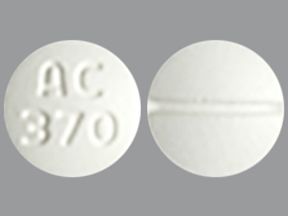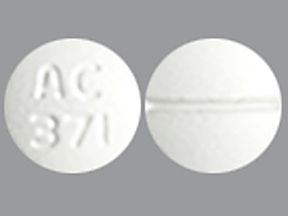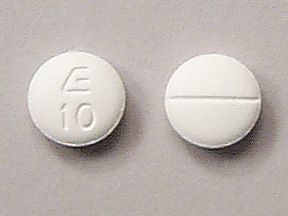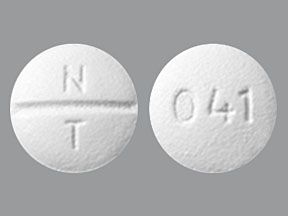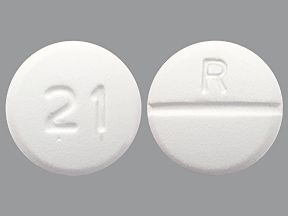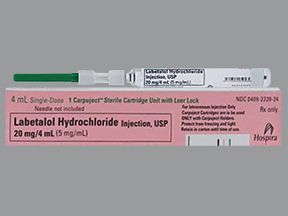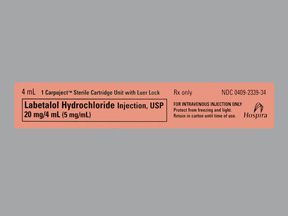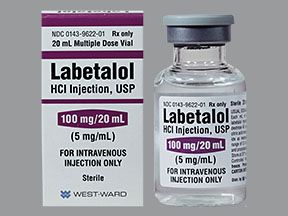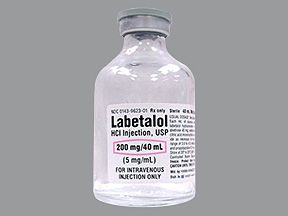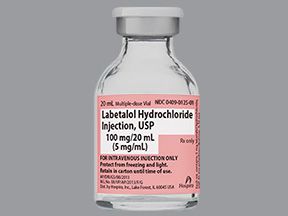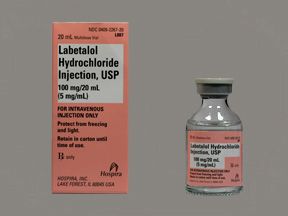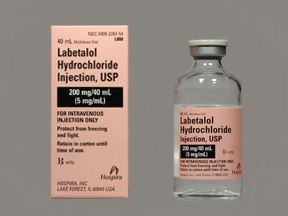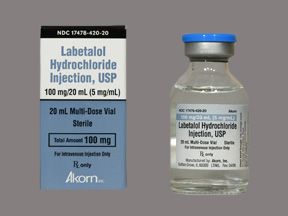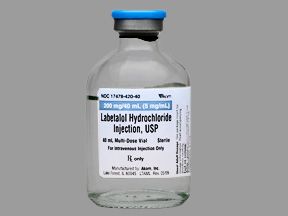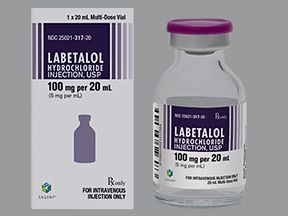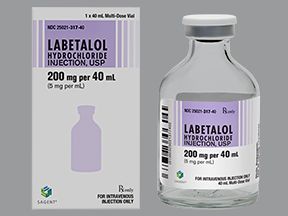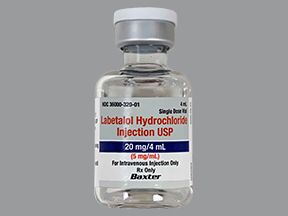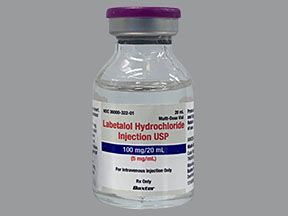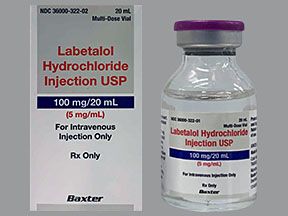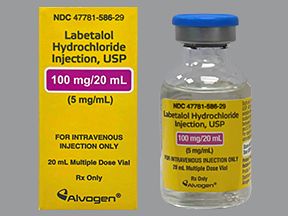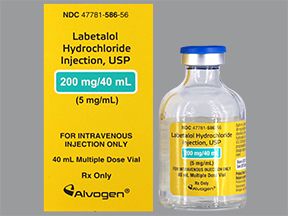Key Takeaways
- Labetalol oral tablet is a generic drug precribed to treat high blood pressure. It works by causing your heart to beat more slowly and with less force to lower blood pressure.
- Labetalol oral tablet has important warnings. This drug should not be used if you have asthma, unstable heart failure, second- or third-degree heart block, or a very slow heart rate. Labetalol oral tablet may worsen these conditions.
- Common side effects of labetalol oral tablet may include dizziness, nausea, and fatigue. Serious side effects of labetalol oral tablet can include very slow heart rate, liver damage, heart failure, and breathing problems that require immediate medical attention.
- Asthma or chronic obstructive pulmonary disease warning: You should not use this drug if you have asthma. If you have chronic obstructive pulmonary disease (COPD), your doctor may have you use this drug with caution only after other drugs have not worked. This drug may make it harder for you to breathe, or it may stop certain breathing medications from working well.
- Heart problems warning: You should not use this drug if you have unstable heart failure, second- or third- degree heart block, or a very slow heart rate. This drug may make these conditions worse. If you have heart disease and you suddenly stop taking this drug, you’re at high risk of angina (chest pain) or a heart attack.
- Liver damage warning: This drug can cause sudden harm to your liver. Symptoms may include itching, dark-colored urine, loss of appetite, jaundice (yellowing of your skin or the whites of your eyes), and pain in the right side of your abdomen. Let your doctor know if you have these symptoms. Your doctor may monitor your liver function while you’re taking this drug.
Labetalol is a prescription drug. It comes in two forms: an oral tablet and an intravenous (IV) injection. The injection is only given by a healthcare professional. Note that this article covers only the oral tablet form of labetalol.
Labetalol oral tablet is only available as a generic drug. A brand-name version of the drug, called Trandate, used to be available but is discontinued. Generic drugs usually cost less than the brand-name version.
Labetalol oral tablet may be taken as part of a combination therapy with other medications that lower your blood pressure. For example, you may take labetalol with certain types of diuretics, such as furosemide (Lasix) or hydrochlorothiazide.
Why it’s used
Labetalol oral tablet is used to reduce high blood pressure, also referred to as hypertension. This lowers your risk of complications from high blood pressure, such as heart attack and stroke.
How it works
Labetalol oral tablet belongs to a class of drugs called beta-blockers. A class of drugs is a group of medications that work in a similar way. These drugs are often used to treat similar conditions.
Labetalol oral tablet works by causing your heart to beat more slowly and with less force. This lowers your blood pressure.
Labetalol can cause mild or serious side effects. The following list contains some of the key side effects that may occur while taking labetalol. This list does not include all possible side effects.
For more information on the possible side effects of labetalol or tips on how to deal with a troubling side effect, talk with your doctor or pharmacist.
More common side effects
More common side effects that can occur with labetalol include:
- dizziness
- nausea
- fatigue (low energy)
If these effects are mild, they may go away within a few days or a couple of weeks. If they’re more severe or don’t go away, talk with your doctor or pharmacist.
Serious side effects
Call your doctor right away if you have serious side effects. Call 911 if your symptoms feel life threatening or if you think you’re having a medical emergency. Serious side effects and their symptoms can include the following:
- Bradycardia (very slow heart rate). Symptoms can include:
- dizziness
- lightheadedness
- fainting
- fatigue
- Orthostatic hypotension (low blood pressure, especially when getting up from a seated position). Symptoms can include:
- dizziness
- lightheadedness
- fainting
- Liver damage. Symptoms can include:
- itching
- dark-colored urine
- loss of appetite
- jaundice (yellowing of your skin or the whites of your eyes)
- tenderness or pain on the right side of your abdomen
- fatigue
- Heart failure. Symptoms can include:
- shortness of breath
- chronic (long-term) coughing or wheezing
- swelling in your legs, ankles, or chest
- fatigue
- lightheadedness
- nausea
- lack of appetite
- confusion or trouble thinking
- Breathing problems. Symptoms can include:
- shortness of breath
- trouble breathing
Labetalol can interact with several other medications. Different interactions can cause different effects. For instance, some can interfere with how well a drug works, while others can cause increased side effects.
Below are some of the medications that can interact with labetalol. This section does not list all drugs that may interact with labetalol.
Before taking labetalol, be sure to tell your doctor and pharmacist about all prescription, over-the-counter, and other drugs you take. Also tell them about any vitamins, herbs, and supplements you use. Sharing this information can help you avoid potential interactions.
If you have questions about drug interactions that may affect you, ask your doctor or pharmacist.
Drugs used to treat depression
Taking labetalol with a tricyclic antidepressant may increase your risk of tremors. Examples of these drugs include:
- amitriptyline
- doxepin (Silenor)
- nortriptyline (Pamelor)
- clomipramine (Anafranil)
Asthma inhalers
Taking labetalol may cause narrowing of your airways. This may make it harder for you to breathe. Because of this, if you take asthma medications, your doctor may increase the dosage of your asthma drugs. Examples of these drugs include:
- albuterol (ProAir)
- salmeterol (Serevent)
- arformoterol (Brovana)
- olodaterol (Striverdi Respimat)
Heartburn medications
Taking labetalol with heartburn medications can increase the amount of labetalol in your body. This can cause more side effects. Examples of heartburn medications include:
- cimetidine (Tagamet HB)
Heart medications
Taking labetalol with certain medications for the heart may cause you to have very low blood pressure and heart rate. Examples of these drugs include:
- nitroglycerin (Nitrostat)
- digoxin (Lanoxin)
- clonidine
- amiodarone (Pacerone)
- disopyramide (Norpace)
- calcium channel blockers, such as:
- nifedipine (Procardia)
- diltiazem (Cardizem)
- verapamil (Verelan)
This drug comes with several warnings.
Allergy warning
This drug can cause a severe allergic reaction. Symptoms include:
- hives
- rash
- itching
- trouble breathing
- swelling of your lips, tongue, or face
If you develop these symptoms, call 911 or go to the nearest emergency room.
Do not take this drug again if you’ve ever had an allergic reaction to it. Taking it again could be fatal.
Alcohol interaction warning
Your body processes alcohol and this drug in similar ways. That means if you drink alcohol, this drug might take longer to leave your body. This could cause worse side effects from labetalol.
Warnings for people with certain health conditions
For people with heart problems: This drug may cause or worsen heart failure. You should not use this drug if you have unstable heart failure, second- or third-degree heart block, or a very slow heart rate. If you have heart disease and you stop taking this medication suddenly, you’re at high risk of chest pain and heart attack.
For people with liver problems: If you have liver problems, your body may not process this drug as quickly as it needs to. This can cause the drug to build up in your system, increasing your risk of side effects. During your treatment with this drug, your doctor may keep you at a lower dosage and watch you more closely.
For people with breathing problems: You should not use this drug if you have asthma. If you have chronic obstructive pulmonary disease (COPD), your doctor may use this drug with caution only after other drugs have not worked. This drug may make it harder for you to breathe, or it may prevent certain breathing medications from working as well.
For people with diabetes: This drug may mask symptoms of low blood sugar, such as a fast heart rate. This drug also lowers the amount of insulin your body releases in response to high blood sugar levels. If you take labetalol, your doctor may need to adjust the dosage of your diabetes medications.
For people with untreated pheochromocytoma: Do not use this medication if you have untreated pheochromocytoma (a tumor that can cause very high blood pressure). It can mask the symptoms of your condition.
For people with cataracts: If you plan to have cataract surgery, let your doctor know you’re taking this drug. This drug can cause a complication called intraoperative floppy iris syndrome (IFIS) during surgery.
Warnings for other groups
For pregnant people: This drug is a category C pregnancy drug. That means two things:
- Research in animals has shown adverse effects to the fetus when a pregnant animal takes the drug.
- There haven’t been enough studies done in humans to be certain how the drug might affect a human fetus.
Tell your doctor if you’re pregnant or plan to become pregnant. This drug should be used during pregnancy only if the potential benefit justifies the potential risk.
If you become pregnant while taking this drug, call your doctor right away.
For people who are breastfeeding: This drug may pass into breast milk and cause serious side effects in a child who is breastfed. You and your doctor may need to decide whether you’ll take this drug or breastfeed.
For older adults: Adults who are older may process drugs more slowly. A typical adult dosage may cause levels of this drug to be higher than usual in such adults. If you’re age 65 years or older, you may need a lower dosage or a different treatment schedule.
For children: This drug hasn’t been studied in children. It should not be used in people younger than age 18 years.
The labetalol dosage your doctor prescribes will depend on several factors. These include:
- the type and severity of the condition you’re taking labetalol to treat
- your age
- the form of labetalol you take
- other medical conditions you may have
Typically, your doctor will start you on a low dosage and adjust it over time to reach the dosage that’s right for you. They’ll ultimately prescribe the smallest dosage that provides the desired effect.
The following information describes dosages that are commonly used or recommended. However, be sure to take the dosage your doctor prescribes for you. Your doctor will determine the best dosage to suit your needs.
Dosage for hypertension (high blood pressure)
Generic: labetalol
- Form: oral tablet
- Strengths: 100 mg, 200 mg, 300 mg
Adult dosage (ages 18 to 64 years)
- Typical starting dosage: 100 mg taken two times per day.
- Typical maintenance dosage: 200 to 400 mg taken two times per day.
- Dosage increases: If needed, your doctor may increase your dosage every 2 to 3 days.
- Maximum dosage: 2,400 mg per day taken in two to three divided doses.
Child dosage (ages 0 to 17 years)
This drug hasn’t been studied in children. It should not be used in people younger than 18 years.
Older adult dosage (ages 65 years and older)
The typical maintenance dosage is 100 to 200 mg taken two times per day.
Labetalol oral tablet is used for long-term treatment. It comes with serious risks if you do not take it as prescribed.
If you do not take it at all: Your blood pressure will stay high and may get worse. You’ll have a higher risk of a heart attack or stroke.
If you stop taking it suddenly: Your risk of chest pain or a heart attack will likely increase. Do not stop taking this drug suddenly. If you need to stop taking this drug, talk with your doctor.
If you do not take it on schedule: Your blood pressure may not improve or may get worse. You may not feel any different, but your blood pressure won’t be well managed. This can increase your risk of a stroke or heart attack.
What to do if you miss a dose: If you forget to take your dose, take it as soon as you remember. If it’s just a few hours until the time for your next dose, wait and only take one dose at that time.
Never try to catch up by taking two doses at once. This could cause dangerous side effects.
If you take too much: If you take too much of this drug, you may have symptoms such as:
- slow heart rate
- low blood pressure
- dizziness
- lightheadedness
- fainting
- trouble breathing
- swelling in your legs, ankles, or chest
- seizures
If you think you’ve taken too much of this drug, call your doctor or local poison control center. If your symptoms are severe, call 911 or go to the nearest emergency room right away.
How to tell this drug is working: Your blood pressure should be lower.
Whether you have health insurance or not, cost may be a factor when you’re considering labetalol. What you’ll pay for labetalol may depend on several things, such as your treatment plan and the pharmacy you use.
Here are a few things to consider regarding cost:
- Cost information and savings coupons: You can visit Optum Perks to get price estimates of what you’d pay for labetalol when using coupons from the site. See the coupon options below. (Note: Optum Perks coupons cannot be used with insurance copays or benefits.)
- Savings programs and other assistance: If you have questions about how to pay for your prescription, talk with your doctor or pharmacist. If you need financial support to pay for labetalol or help to understand your insurance coverage, try one of these sites:
- Medicine Assistance Tool
- NeedyMeds
You can also check out this article to learn more about saving money on prescriptions.
Keep these considerations in mind if your doctor prescribes labetalol for you.
General
- Do not crush, chew, or break the tablets.
Storage
- This drug must be stored at the right temperature. Store it at room temperature between 59°F and 86°F (15°C and 30°C).
- Keep this drug away from high temperatures.
- Keep it away from light.
- Do not store this medication in moist or damp areas, such as bathrooms.
Refills
A prescription for this medication is refillable. You should not need a new prescription for this medication to be refilled. Your doctor will write the number of refills authorized on your prescription.
Travel
When traveling with your medication:
- Always carry your medication with you. When flying, never put it into a checked bag. Keep it in your carry-on bag.
- Do not worry about airport X-ray machines. They can’t harm your medication.
- You may need to show airport staff the pharmacy label for your medication. Always carry the original prescription-labeled container with you.
- Do not put this medication in your car’s glove compartment or leave it in the car. Be sure to avoid doing this when the weather is very hot or very cold.
Self-management
Your doctor may ask you to check your blood pressure at home. You should keep a log with the date, time of day, and your blood pressure readings. Bring this log with you to your doctor appointments.
You’ll need to purchase a blood pressure monitor to check your blood pressure at home.
Clinical monitoring
While you’re taking this drug, your doctor will monitor your:
- blood pressure
- heart rate
- liver function
Hidden costs
You may need to purchase a home blood pressure monitor to keep track of your blood pressure. These monitors are available at most pharmacies.
There are other drugs available to treat your condition. Some may be better suited for you than others. Talk with your doctor about other drug options that may work for you.
Disclaimer: Healthline has made every effort to make certain that all information is factually correct, comprehensive, and up to date. However, this article should not be used as a substitute for the knowledge and expertise of a licensed healthcare professional. You should always consult your doctor or another healthcare professional before taking any medication. The drug information contained herein is subject to change and is not intended to cover all possible uses, directions, precautions, warnings, drug interactions, allergic reactions, or adverse effects. The absence of warnings or other information for a given drug does not indicate that the drug or drug combination is safe, effective, or appropriate for all patients or all specific uses.





